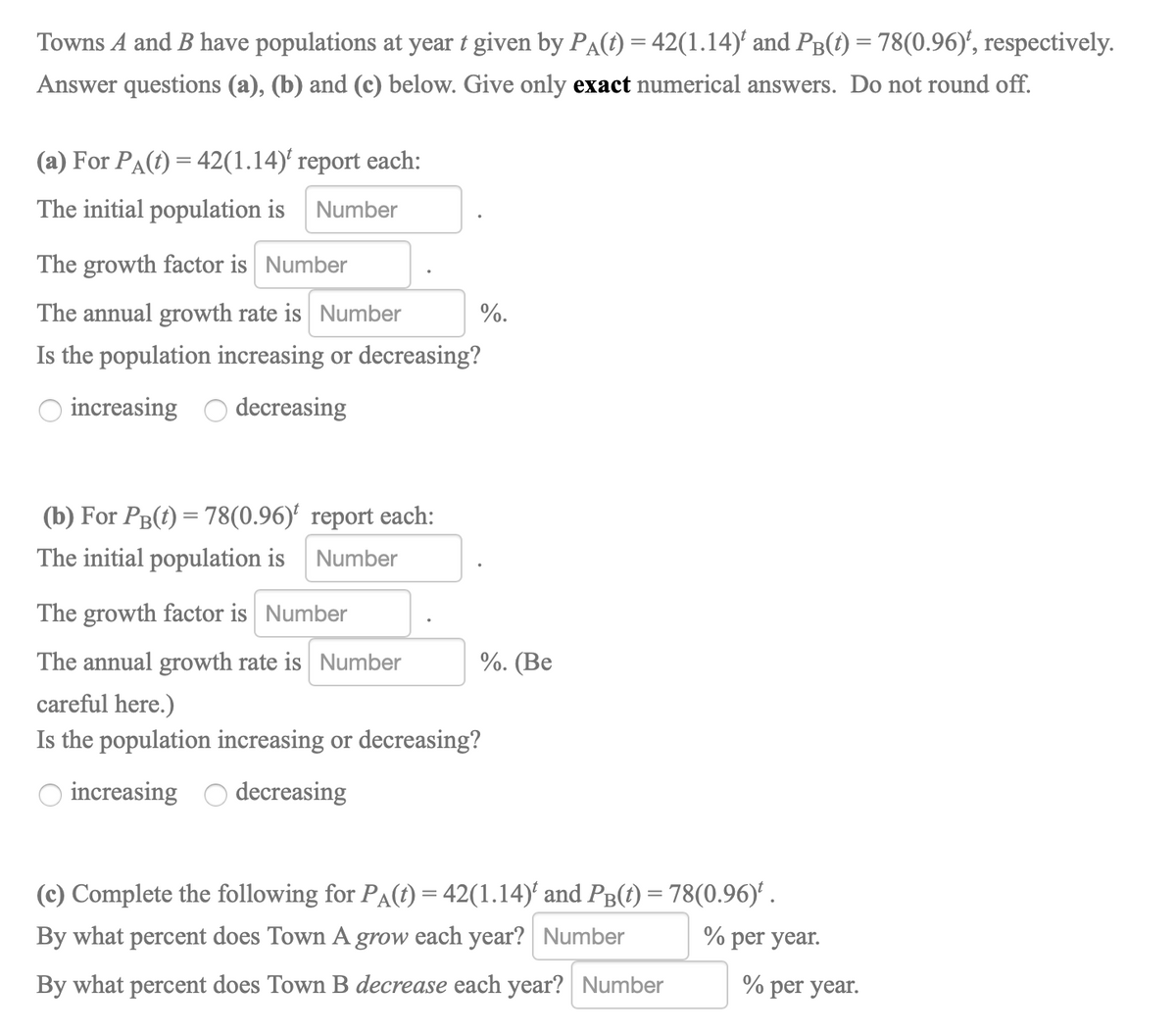Towns A and B have populations at year t given by PA(t) = 42(1.14)' and PB(t) = 78(0.96)ʻ, respectively. Answer questions (a), (b) and (c) below. Give only exact numerical answers. Do not round off. (a) For PA(t) = 42(1.14)' report each: The initial population is Number The growth factor is Number The annual growth rate is Number %. Is the population increasing or decreasing? increasing decreasing (b) For PB(t) = 78(0.96)' report each: The initial population is Number The growth factor is Number The annual growth rate is Number %. (Ве careful here.) Is the population increasing or decreasing? increasing decreasing (c) Complete the following for PA(t) = 42(1.14)' and Pg(t) = 78(0.96)' . By what percent does Town A grow each year? Number % per year. By what percent does Town B decrease each year? Number % per year.
Towns A and B have populations at year t given by PA(t) = 42(1.14)' and PB(t) = 78(0.96)ʻ, respectively. Answer questions (a), (b) and (c) below. Give only exact numerical answers. Do not round off. (a) For PA(t) = 42(1.14)' report each: The initial population is Number The growth factor is Number The annual growth rate is Number %. Is the population increasing or decreasing? increasing decreasing (b) For PB(t) = 78(0.96)' report each: The initial population is Number The growth factor is Number The annual growth rate is Number %. (Ве careful here.) Is the population increasing or decreasing? increasing decreasing (c) Complete the following for PA(t) = 42(1.14)' and Pg(t) = 78(0.96)' . By what percent does Town A grow each year? Number % per year. By what percent does Town B decrease each year? Number % per year.
Chapter5: Exponential And Logarithmic Functions
Section5.5: Exponential And Logarithmic Models
Problem 30E: The table shows the mid-year populations (in millions) of five countries in 2015 and the projected...
Related questions
Question

Transcribed Image Text:Towns A and B have populations at year t given by PA(t) = 42(1.14)' and PB(t) = 78(0.96)', respectively.
Answer questions (a), (b) and (c) below. Give only exact numerical answers. Do not round off.
(a) For PA(t) = 42(1.14)' report each:
The initial population is Number
The growth factor is Number
The annual growth rate is Number
%.
Is the population increasing or decreasing?
increasing
decreasing
(b) For PB(t) = 78(0.96)' report each:
The initial population is Number
The growth factor is Number
The annual growth rate is Number
%. (Ве
careful here.)
Is the population increasing or decreasing?
increasing
decreasing
(c) Complete the following for PA(t) = 42(1.14)' and PB(t) = 78(0.96)' .
By what percent does Town A grow each year? Number
% per year.
By what percent does Town B decrease each year? Number
% per year.
Expert Solution
This question has been solved!
Explore an expertly crafted, step-by-step solution for a thorough understanding of key concepts.
This is a popular solution!
Trending now
This is a popular solution!
Step by step
Solved in 2 steps with 1 images

Knowledge Booster
Learn more about
Need a deep-dive on the concept behind this application? Look no further. Learn more about this topic, algebra and related others by exploring similar questions and additional content below.Recommended textbooks for you


Algebra & Trigonometry with Analytic Geometry
Algebra
ISBN:
9781133382119
Author:
Swokowski
Publisher:
Cengage

Glencoe Algebra 1, Student Edition, 9780079039897…
Algebra
ISBN:
9780079039897
Author:
Carter
Publisher:
McGraw Hill


Algebra & Trigonometry with Analytic Geometry
Algebra
ISBN:
9781133382119
Author:
Swokowski
Publisher:
Cengage

Glencoe Algebra 1, Student Edition, 9780079039897…
Algebra
ISBN:
9780079039897
Author:
Carter
Publisher:
McGraw Hill
